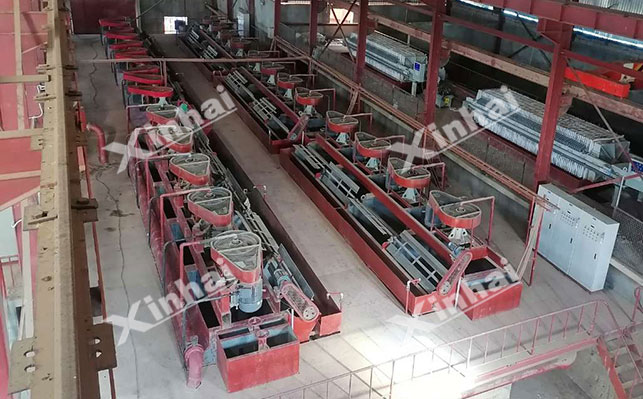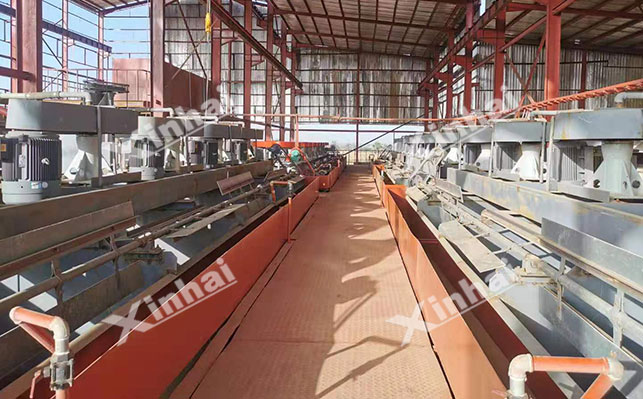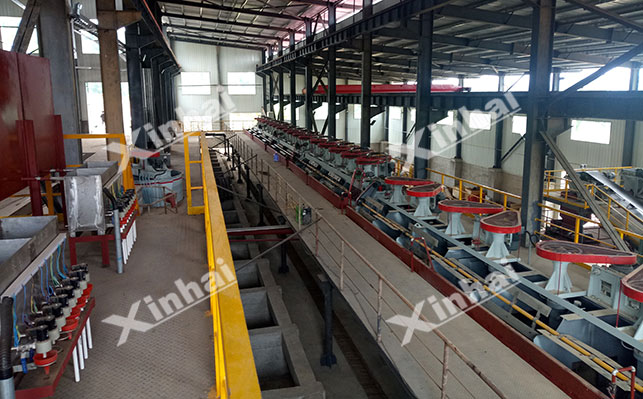
15311826613
Click to add WeChatCopper-lead-zinc ores are common polymetallic mineral types and important raw materials for the non-ferrous metals industry. Their ore types are complex, often existing as sulfide ores, oxide ores, or mixed ores. Due to the close association of copper, lead, and zinc minerals and their similar floatability, effective separation is quite difficult. This article will introduce copper-lead-zinc ore separation and copper-lead-zinc ore beneficiation technologies from multiple perspectives.
Sulfide Ores: Mainly containing chalcopyrite, galena, and sphalerite, these are common industrial types with good floatability but mutual interference.
Oxidized Ores: Including malachite, cerussite, and smithsonite, their high degree of oxidation often leads to decreased floatability, requiring special activation treatment.
Mixed Ore: Sulfide and oxide ores coexist, requiring careful consideration of different mineral characteristics during separation, resulting in high process complexity.

Similar Floatability: The surfaces of copper, lead, and zinc sulfide minerals readily react with xanthate collectors, making effective separation difficult with traditional flotation.
Fine Particle Size: Minerals are often interspersed at the micron level, requiring fine grinding to a minimum of -0.074mm (70% or more) for individual liberation. However, fine grinding easily leads to mud formation, increasing reagent consumption.
Unavoidable Ion Interference: Metal ions such as Cu²⁺ and Pb²⁺ in the pulp can activate sphalerite, reducing zinc flotation selectivity; they also consume collectors, affecting separation accuracy.
Based on the differences in the properties of copper-lead-zinc ores, beneficiation often relies on flotation, including preferential flotation, mixed flotation, and equal-probability flotation.

Preferential flotation of copper, lead, and zinc is a method based on their differences in floatability, sequentially flotating and recovering the target minerals in order (copper > lead > zinc). In the flotation operation, zinc minerals are first suppressed with zinc sulfate and sodium sulfite. Simultaneously, xanthate collectors selectively adsorb onto the surfaces of chalcopyrite and galena, making them hydrophobic and causing them to float to form a mixed copper-lead concentrate. The mixed copper-lead concentrate is then separated by flotation, with two processes: lead suppression and copper flotation, and copper suppression and lead flotation. The basic process is as follows:
Zinc Suppression and Copper/Lead Flotation: Minerals ground to -0.074mm (75% concentration) are treated with ZnSO₄ to suppress active sites on the sphalerite surface and Na₂SO₃ to suppress oxygen in the pulp, reducing sphalerite floatability. Ethyl xanthate or butyl xanthate collectors are used to selectively collect copper and lead sulfides.
Copper/Lead Separation: Firstly, lead suppression and copper flotation: The pulp is regrinded to -0.045mm (90% concentration). The surface of galena is oxidized with potassium dichromate to form a hydrophilic chromate film, suppressing its floatability and preferentially flotating chalcopyrite. Secondly, copper suppression and lead flotation: Cyanide is used to suppress chalcopyrite, preferentially flotating lead.
Zinc flotation: The surface activity of sphalerite is restored using CuSO₄ activator, followed by collection of zinc minerals using isobutyl xanthate or butylammonium black reagent collectors. After multiple scavenging processes, zinc concentrate is obtained.
Preferential flotation of copper, lead, and zinc can obtain high-grade single-metal concentrates and is suitable for sulfide copper-lead-zinc ores with high copper grades and significant differences in mineral floatability.

Mixed flotation is often suitable for processing ores where copper and lead minerals are closely associated, especially for low-grade complex ores.
The method involves first obtaining a mixed ore of the two minerals, and then separating the mixed concentrate to obtain copper concentrate and lead-gold ore.
In the mixed flotation stage, a combination collector is often used to simultaneously capture copper and lead minerals, resulting in a strong collecting capacity. Simultaneously, a combination depressant is added to suppress sphalerite and prevent it from floating during the mixed flotation process. After roughing and cleaning operations, a mixed concentrate with a high copper-lead grade can be obtained. The basic process is as follows:
Copper-Lead Mixed Flotation: A combination collector of ethyl thiocyanate and xanthate is used. Ethyl thiocyanate selectively captures copper and lead, while xanthate enhances the collecting capacity. Depressants ZnSO₄ + Na₂SO₃ are used to suppress sphalerite and gangue minerals, resulting in a copper-lead mixed concentrate with a grade >15%. Copper-Lead Separation: Sodium mercaptoacetate (SGA) is used as an inhibitor, selectively adsorbed onto the surface of galena to hinder xanthate adsorption. The pH is adjusted to 7-8 with NaHCO₃, and the pulp temperature is controlled at 30-35℃ to enhance reagent activity and achieve effective separation of copper and lead.
Zinc Recovery: After iron impurities are removed from the tailings by magnetic separation, zinc oxide is floated using a combination of sodium sulfide activation and amine collectors.

Flotation based on similar floatability involves grouping minerals together according to their natural floatability, grouping minerals with similar floatability into a single group, and then performing flotation in stages. During flotation, copper, which has higher floatability, is usually floated first. Then, the amount of collector is increased to float lead minerals. The tailings are then activated by adding activators such as copper sulfate, and sphalerite is floated again using a collector.
The basic process typically involves group flotation, which can be divided into three stages: first, float highly floatable copper minerals; then, float moderately floatable lead minerals; and finally, activate zinc flotation to obtain copper, lead, and zinc concentrates, respectively.
Stage 1: A low dose of xanthate is used for preferential flotation to remove highly floatable copper sulfides, yielding a rough copper concentrate.
Stage 2: A medium dose of xanthate is used to float galena, while Na₂S is added to activate some lead oxide minerals, yielding a lead concentrate.
Stage 3: Copper sulfate is used to activate zinc, followed by a high dose of xanthate to float sphalerite, yielding a zinc concentrate.
This stepwise flotation method improves selectivity while effectively reducing the amount of depressant used. This method avoids the need for overall suppression of all minerals, reducing production costs and minimizing environmental pollution from reagents. It is particularly suitable for processing complex copper-lead-zinc ores where the differences in mineral floatability are not significant.

The above is an introduction to the beneficiation methods for copper-lead-zinc polymetallic ores. Generally, preferential flotation or mixed flotation methods are used for sulfide ores; oxide ores require pretreatment before flotation; and mixed ores often use a combined process of "preferential flotation of sulfide ores + sulfide flotation of oxide ores". However, in actual beneficiation plants, due to the varying mineralization conditions and properties of copper, lead, and zinc minerals, the beneficiation methods also differ. The above content is for reference only. If you have beneficiation needs, please consult Xinhai. We can conduct beneficiation test analysis and tailor a suitable process flow for you.